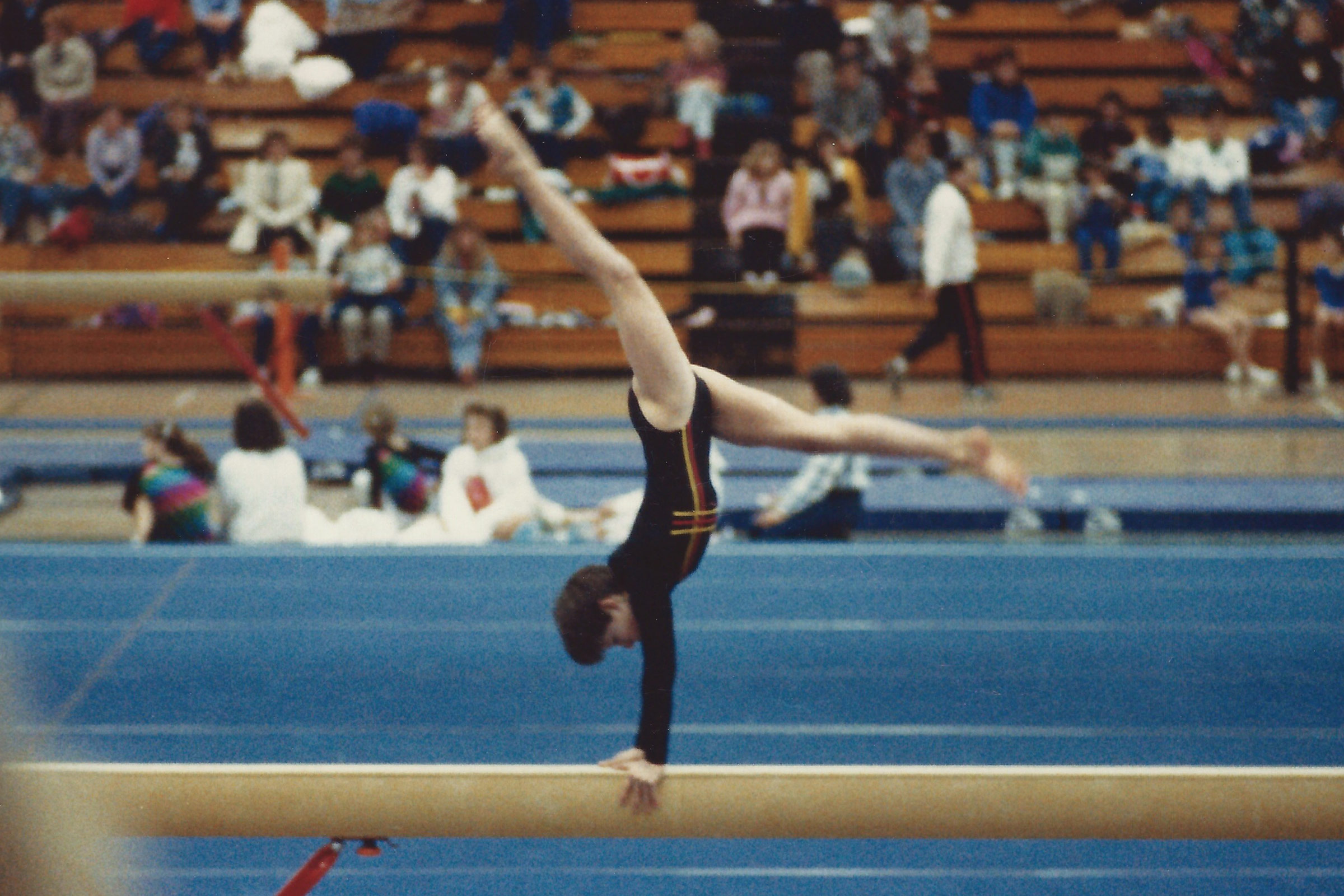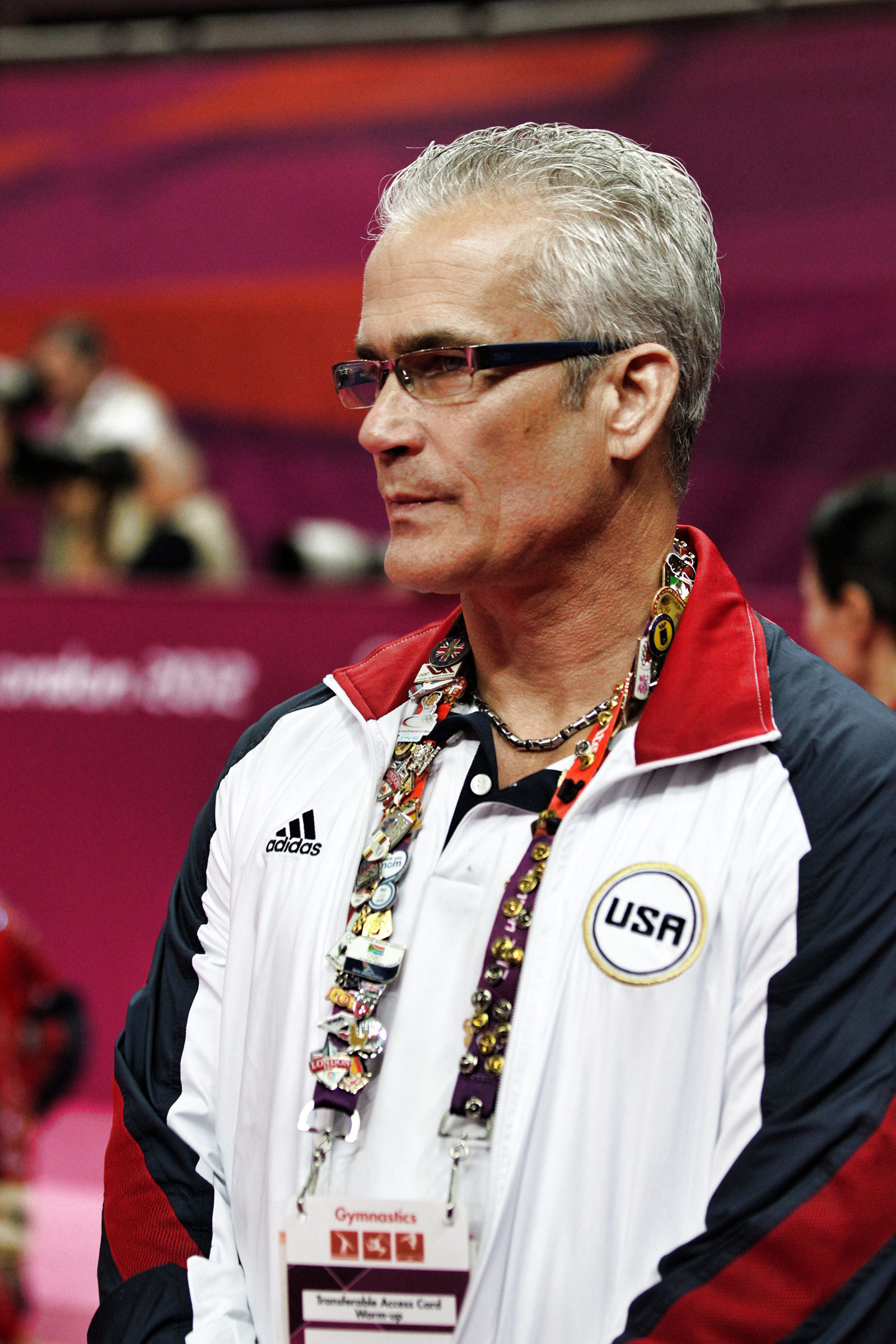
Sara Teristi saw the making of a monster. She watched a man transform from doctor to predator, starting decades ago when he gained access to a gym full of little girls. She was one of those girls. She may have been his very first target.
She first met Larry Nassar–the most prolific known sex criminal in American sports history–at a gym in Michigan in late 1988. She was a young gymnast in a vulnerable state, she says, having been emotionally trampled by her hard-driving coach, John Geddert, a man who made her feel worthless. Nassar, who was volunteering as team doctor, zoomed in on her right away.
Now in her 40s, Sara tells me her story in a quiet courtyard of an art museum near her home in Raleigh, N.C. She is sharing her experience publicly for the first time, much of it recently pieced together after repressing the memories for decades, and she does not want to tell this tale in her house, around her two young sons. She remembers how Geddert created a culture of fear at the gym–shoving her, berating her, mocking her body–and how she lost her sense of self. She recalls that he watched while Nassar sexually abused her.


Today, she wears a metal knee brace from old gymnastics injuries. Physical pain is a part of her everyday life. Then there are the psychological scars. “People don’t understand how many broken girls it takes to produce an elite athlete,” she says, delivering the haunting words with the perfect posture of a gymnast. “A coach can easily go through 300 girls, or more.”
More from TIME
Sara has detailed the events in this story, piece by piece, to two police departments in Michigan, starting after Nassar’s sentencing in 2018, and has provided TIME with those reports. She is also participating in a mass tort suit against Nassar, Geddert and other individuals and institutions. Attorneys for Geddert did not respond to requests for comment on the allegations in this story. An attorney for Nassar said the former doctor is not doing interviews.
Nassar and Geddert worked together for nearly three decades at gyms in Michigan, rising to the top of the sport as Olympic doctor and coach. Geddert led the U.S. women’s team to win gold at the 2012 Olympics. All the while, Nassar abused hundreds of young women and girls while pretending to treat them. He is now behind bars, where he will spend the rest of his life. Dozens of officials have been ousted or charged with crimes in the case.

Geddert was suspended by USA Gymnastics, the governing body for the sport, in January 2018. He promptly announced his retirement, saying in a letter to parents that the suspension was based on false allegations. Michigan police opened an investigation into unspecified complaints against him; the state attorney general took over the case this year amid increasing pressure from gymnasts and their families. They have accused him of mentally and physically abusive coaching and of helping to enable Nassar’s sexual abuse.
I spoke with a dozen former gymnasts–from across the decades–who said Geddert ran an extreme training regimen in which girls lost sight of their bodies, their boundaries, themselves. They told me he took advantage of their passion for the sport and the inherent trust that their parents placed in him–the man who could help them achieve their dreams. That unmooring of their fundamental identities created an environment for a predator like Nassar to harm gymnast after gymnast, unchecked.
Growing up in the tiny town of Dimondale, Mich., Sara, whose last name was Faculak at the time, was an exuberant kid. She had a hard time sitting still, especially when her dad came home from work in his state-trooper uniform, looking for a little peace. And so, in September 1980, when she was 5 years old, her mother enrolled her in a gymnastics class, hoping she could burn off some energy there.
The class was part of a youth program at Michigan State University, in nearby East Lansing. Sara’s mom drove her there in her powder blue Datsun 210, and Sara, with her auburn hair in braids like Laura Ingalls from Little House on the Prairie, bounded into the gym in her leotard. The sport made Sara more energetic, not less. She used her bed as a trampoline, bouncing so high she scraped her nose on the ceiling. She did handstands against the closet door, causing the dog to bark in confusion. Over the next few years, she moved up to an advanced group and began practicing alongside girls more than twice her age.
In 1984, when she was 10, her coach recommended that Sara try out for a prestigious club in Lansing called Great Lakes Gymnastics, where an ambitious coach in his late 20s, John Geddert, was gaining a reputation for training stellar athletes. Geddert, a former gymnast at Central Michigan University, had coached at a top club in Maryland, MarVaTeens Gymnastics, before returning to Michigan, where he grew up.
At high-level gymnastics clubs such as these, young athletes train to compete in state, national or international meets. They can get on track for a college scholarship. Or maybe, for a lucky few, the Olympics. Jordyn Wieber, who won team gold with the U.S. in 2012, grew up in a town just down the road from Dimondale. There is always the dream.
Sara wanted to go for it. She leaped and flipped her way through the tryouts, showing no fear. A few days later, she heard the news: she had been accepted. It was the happiest day of her young life.
At Great Lakes Gymnastics, Sara entered a new world–a boot camp. She welcomed the challenge. She wanted to prove she could hack it, especially since her parents were investing in her training. She decided she would help repay them by getting a college scholarship one day.
She sought perfection in practice, hoping to impress the demanding Geddert. “He would throw clipboards at the girls if they messed up,” she tells me. “He would call them worthless.” Her first experience with his temper came when she was around 11, trying to do a roundoff–back handspring–back tuck. She took off poorly and landed on her head. “He was supposed to spot me,” which she says could have prevented the fall. “But he was angry that I had started off wrong. He turned his back and walked away.” She got up alone, her face rug burned and throbbing. Instead of being mad at her coach, Sara was mad at herself. Geddert blamed the girls for their injuries, accusing them of not concentrating, so they learned to hide their pain and suppress their instinct to speak up when they felt they were treated unfairly.
TIME spoke with eight other gymnasts who trained at Great Lakes at the same time as Sara. Four of them said they experienced or witnessed Geddert berating girls, getting physical, or kicking and throwing items out of anger. Several of those women also said that he failed to spot them, as a punishment. The other four said they had neutral experiences at the gym.
Body weight was a stress point. The girls were weighed regularly at the gym. If they didn’t “make weight,” they were sentenced to run laps around the parking lot in their leotards. Sara remembers feeling humiliated, with cars driving by and honking, guys catcalling.
Sometimes Sara was ridiculed inside the gym as well. When she did handsprings, she had a hard time keeping her legs together because of a birth defect, she says. Geddert mocked her, making sexual jokes. “He said the boys would love me because I couldn’t keep my legs together,” she says. She felt mortified as he snickered, her face turning deep red.
Another time, Geddert got physical with her, she says, recalling a day when she didn’t do well on the vault at practice. “As I was sprinting at full speed down the vault runway to try again, he shoved me, midsprint,” she says. She went flying sideways, smashing into the uneven bars. Bruised, she got up to try again, feeling ashamed.
Sara didn’t tell her parents about the rough treatment at the gym because as far as she knew, this was the norm if you wanted to be a top gymnast. Looking back, she describes the experience as “brainwashing.” She was a young girl; Geddert was an adult man. He had all the power. She felt she could never do enough to earn his respect, so she became obsessed with trying to get it. “I was a perfectionist,” she says. “And he was a drill sergeant.” Her world became all about him. “I would’ve done anything to make John happy,” she says. “Eventually, I saw him more than I saw my own parents.”
The club moved to a new space: a rented gym in an old, shuttered school, the Walter French Junior High School, with no air-conditioning. “One day, after five or six hours of practice, the heat really got to me,” she says. “I felt dizzy.” She got permission from a coach to go to the bathroom, where she lay on the floor, hoping she wouldn’t get in trouble for resting. She got busted immediately. “John came in and said, ‘You’re faking it. Get up!'” she says. “If he noticed you weren’t in the gym, he’d go searching for you in the bathroom.” It’s a habit he continued over time: three other former gymnasts told me he walked in on them in the locker room in more recent years. In retrospect, Sara says this is part of how she began to lose a sense of boundaries.
Then, around the time she was 12, she suffered an injury so extreme she could not possibly hide it from her coach.
While doing a dismount from a balance beam, she felt her body twisting badly. In that moment, she didn’t think she needed to adjust herself; she thought she would be fine landing in a pit of foam blocks. Instead, she landed on her backside with such force, she says, that her feet flew up over the front of her head and her chin smashed into her sternum–actually breaking the bone. The shock and pain were so great, she could hardly move. Still, she tried to pull herself out of the pit. Geddert asked what was taking so long. “I said I was hurt; he said I was lying and to get up and do it again,” she says. “I could feel my whole rib cage moving around in my chest. I could barely breathe.” She tried to get back up on the beam. She collapsed instead.
In the emergency room, she learned the awful news: her sternum had been broken in two places. But Sara was determined to return to the gym as soon as her doctors would allow. Her parents urged her to quit the sport, but she persuaded them to let her continue. They didn’t want to end her dreams, so they reluctantly agreed.
Six months later, Sara went back to the gym–thrilled to be there. But during practice, everything felt physically out of whack. Geddert noticed. When she landed on her hands and knees after a vault, she says he sat on her, pinning her down. “He was sitting on my back, riding me in a sexual way,” she says. “He said, ‘Ooh, baby, you like it like that!'”
She tried valiantly to get back to form, but it wasn’t happening quickly, and she felt lost. She knew she was fading in her coach’s eyes. “I wasn’t on the same trajectory that I once was,” she says. “He was disappointed in me. I could feel it.”
Geddert, meanwhile, was gaining in national prominence. He had a number of high-level gymnasts now. He wanted Olympians.
Then one day, Larry Nassar walked in the door.
On his first day at Great Lakes Gymnastics, Nassar stood awkwardly as Geddert introduced him to the girls, describing him as a student in medical school at Michigan State. It was late 1988, and Nassar had come to volunteer at the gym. Sara’s first impression of the new doctor: “He was geeky, nerdy,” she says. “He had this Revenge of the Nerds laugh, and we all giggled about that.”
Nassar was building a résumé working with gymnasts. He had served as an athletic trainer for the U.S. National Team and had volunteered at both the Pan American Games and the Olympic trials. “He actively sought out situations where he could touch little girls all day,” says James White, a Lansing attorney who represents Sara and other survivors.
Sara, 14 at the time, was still striving for a full comeback from her snapped sternum, pushing herself hard. One day, while practicing on the uneven bars, she was doing a release move, letting go of the high bar to grab the low bar, when she missed the low bar and slammed into it from behind, smacking her back. A fiery pain shot through her upper body. When Geddert found out, he kicked a bucket in anger, she recalls. “Then he yelled, ‘Go see Larry!'”
Nassar examined Sara in the back room, concluding that she had dislocated several ribs. Then he iced her chest and sent her to tell Geddert she was injured. Her coach brushed her off, she says, so she continued training. She didn’t take time off, didn’t go to the hospital. She did not dare complain. Years later, she learned that at least one of the ribs had actually been broken at the time. “You develop a high threshold for pain,” she explains. Still, she was only human. A few days after injuring her ribs, she tried to bench-press, but couldn’t lift the bar all the way and let it slam down. “John got mad and asked what was wrong,” she says. “I told him it hurt. Then he said, ‘If you’re gonna be that much of a wimp, then get out of my gym!’ So I sucked it up and finished my sets.”
She began seeing Nassar regularly. He would massage her chest with ice that had been frozen into little paper cups. At first, he left her leotard in place for this process. But soon, he began moving her leotard down. First he moved the straps down over her shoulders. Then he moved her bra straps down. Later he pushed the leotard and bra down low on her chest, until her nipples were exposed. Today, Sara believes he was testing to see how much he could get away with. At the time, she thought he must have a reason for doing what he did. Like many kids, she had been taught to trust doctors.
Nassar, emboldened, went a step further. “I remember the first time he touched my nipples,” she says. “Usually, after he iced my chest, he would dab away any excess water with a paper towel. But this time he took the paper towel and wiped my nipples, even though they weren’t wet. I thought, ‘Why is he doing that–I’m not wet there.’ Then I felt his finger touch my nipples. He massaged them and pinched them.”
Then things got even more strange. As she lay there, “frozen,” she says, Nassar suddenly got angry and ordered her to leave the room. “He said, ‘You have to ice your own chest from now on.'” Sara didn’t know what sparked the mood swing. “I was so confused,” she says, “I thought I had done something wrong.”
She wonders now if he panicked after going too far with her. Perhaps he pulled back to compose himself after losing control.
After that odd day, she didn’t see him for a couple of weeks. Then one day, he invited her back. “This time, he undressed me right away and went straight for my nipples,” she says. “He wasn’t testing the waters anymore.”
The ice “treatment” with Nassar continued, she says, sometimes with Geddert in the room. As she lay on her back, topless, she says Geddert saw Nassar touch her nipples. “They would stand there and have a conversation right in front of me,” she says. “John would joke about how small my ‘tits’ were. He said if I was lucky, they would get bigger.” But she wasn’t surprised by much of anything at this point. After all, Geddert walked in on the girls in the bathroom, she says. No boundaries, no privacy. Sara believes Geddert helped make her vulnerable to the abuse from Nassar, trampling her psyche to a point where she had lost her sense of self. “Your body didn’t belong to you,” she says. “You didn’t get to make decisions about it.”
TIME confirmed that Sara reported this abuse to a close family friend as well as the police in 2018. Like many survivors of childhood sexual abuse, she did not tell anyone at the time, because she did not recognize it as abuse. For Sara and many other Nassar survivors, it was not until after the former doctor’s arrest and sentencing that they realized what had been done to them.
Sara says Geddert then took his taunting further. She had developed a lump on her chest where one of her ribs had reconnected badly, and he began calling it her “third boob,” she says. He joked that her other two breasts needed to catch up to the size of the third.
“You’re a kid–you laugh it off. I started calling it my third boob too,” she says. “But deep down, it devastated me.” Later, she says, Geddert started using Third Boob as her nickname.
As Sara’s pain continued, her mother pressed her to quit. “I told her there was no way she could make me,” Sara says. She had worked too hard to give up. So she persuaded her mom to let her seek medical help for pain management and keep going.
Nassar then began a new “treatment” with Sara, kneading her bare back, down to her rear, which was partially exposed, making her feel self-conscious. The procedure was painful, and she told him it hurt, assuming he would stop. But no. “He took his elbow and ground it into my back even harder,” she says. She tells me she finds it interesting that many of his more recent victims have described Nassar as a nice guy. He was not nice to her. Sara believes that with her in those early days, he was always testing, learning, figuring out how far he could push it with his young patients.
He was also learning how to ingratiate himself with those who would enable his abuse, a practice that would lead him from treating gymnasts at Great Lakes to athletes at Michigan State University and USA Gymnastics. Sara believes she witnessed a defining moment in that process. One day during practice, she saw a gymnast get injured, and Nassar told Geddert that the girl should take a week off. “John got pissed and started throwing things,” Sara says. “I remember Larry watching. And then, slowly, very methodically, he changed his mind and said, ‘Actually, she doesn’t need a week off.'” The coach stopped raging. He asked Nassar if he was sure. The answer: yes.
Sara thinks Nassar realized that the way to keep his access to the girls was to please Geddert. And the way to please Geddert was to clear the girls to keep training and competing while injured. “After that,” she says, “Larry went along with whatever John wanted.”
By the time she was 16, Sara had developed a new injury: a hairline fracture in her tailbone from repetitive stress. The injury threatened her dream–and presented a new opportunity for Nassar.
Sara has a difficult time discussing what happened next, but thinks it’s important to do so, she says, to help people understand how predators operate. She remembers lying facedown on a table in the back room of the gym, gripping the sides of the table in pain during a procedure, wanting it to stop. Nassar was penetrating her anally with his hands, without using gloves or medical lubricant. She recalls a musty smell in the room at times; in retrospect, she believes he was ejaculating while she lay there.
At the time, she didn’t understand. Sexual abuse wasn’t on her radar. And neither was sex. She had never dated boys; there was no time for that, what with the demands of training and school. She knew only that the procedure was excruciating and that it felt endless. She didn’t tell anyone because she trusted that her doctor was performing a medical treatment.
By this point, she says, any sense of personal boundaries at the gym was lost. She recalls how the girls would do the splits at practice, with Geddert measuring how close they could get to the floor, using a ruler or tape measure, to gauge their flexibility. While he measured her, she says he touched and rubbed her crotch through her leotard, smirking and saying he was trying to get a better measurement. Four of the former Great Lakes gymnasts TIME spoke with confirmed that Geddert routinely measured their splits manually. To Sara, it was all part of a world where her body was not her own.
As she entered her senior year of high school, in 1991, Nassar’s abuse escalated. He began taking her and other girls from the gym to his apartment, under the guise of either medical research or treatment. Two other former gymnasts told me he took them there as young girls during this time as well, recalling that he had them take baths–ice baths to ease their pain or hot baths to increase their flexibility, or so he said–then he penetrated them vaginally or anally with his bare hands.
Sara says the smell of potpourri–which he kept in a bowl on his toilet in his bathroom–has haunted her throughout her life.
Sara’s senior year would be her last in gymnastics.
On the day she said goodbye to Geddert, she drove to the gym in her 1978 Oldsmobile Cutlass, crying all the way. “I was trying to figure out if I was doing the right thing,” she says. “I thought I was being weak.” When she parked the car, her ribs throbbed in pain as she turned the steering wheel, and she knew she’d made the right call. She walked into the gym and told her coach she was done.
His response surprised her–he was kind, telling her she was welcome back anytime. Sara would puzzle over that mysterious final moment for years to come. Today she wonders, “Did he feel guilty for breaking me? Was he trying to keep me there for Larry, or to keep me quiet about what Larry did to me?”
In college, Sara suffered from anxiety and depression, and she tried to tell a campus counselor about her painful years at the gym–to no avail. “She interrupted me to ask if I was embellishing,” Sara says. “She said no coach or doctor would be allowed to treat their athletes that way.” Sara, in her emotionally fragile state, buried her childhood experience.
More than two decades later, when her father alerted her to Nassar’s arrest, Sara tried not to think about it. Busy raising her family in North Carolina at the time, she did not want to remember those dreadful years in gymnastics. She had long since put all of that away.
As much as Sara wanted to leave her past behind, however, she could not ignore the widening scandal in the news. In early 2018, when she saw more than 150 women stand up to give their victim-impact statements in court, the memories came crashing back. “I felt dizzy, like I would vomit,” she says. Her brain fought with itself as she tried to accept that she had been sexually abused. An excruciatingly difficult year followed.
Today, she says she wrestles more with the psychological abuse of her coach than the sexual abuse of the doctor. She continues to blame herself for getting injured. It had been so thoroughly drilled into her head that injuries were her fault. She recalls the day she broke her sternum–that instant during the dismount when she didn’t adjust to land better. When she crashed and snapped her sternum, it angered her coach and led her to the doctor, setting the abuse in motion. She recognizes that she was a child–exhausted, hungry, overheated. But still, she says, “I never should have let my body relax. You can never let up.”
She is working to rewire her thinking. “My therapist tells me to talk to the girl inside me,” she says. She is focusing on family, and on the long road to healing. Her fellow survivors are a source of camaraderie and support. Her hope is “to see justice served for John Geddert,” she says. She believes she is getting stronger, gradually. “If I can handle this,” she says, “there’s not a whole lot I can’t handle.”
Pesta is an award-winning investigative journalist and author whose work has been featured in the New York Times, the Wall Street Journal, the Atlantic, and many other outlets. This piece is adapted from her new book The Girls: An All-American Town, a Predatory Doctor, and the Untold Story of the Gymnasts Who Brought Him Down, by Abigail Pesta. Copyright © 2019 Published by arrangement with Seal Press, an imprint of Hachette Book Group, Inc.

More Must-Reads from TIME
- Donald Trump Is TIME's 2024 Person of the Year
- Why We Chose Trump as Person of the Year
- Is Intermittent Fasting Good or Bad for You?
- The 100 Must-Read Books of 2024
- The 20 Best Christmas TV Episodes
- Column: If Optimism Feels Ridiculous Now, Try Hope
- The Future of Climate Action Is Trade Policy
- Merle Bombardieri Is Helping People Make the Baby Decision
Contact us at letters@time.com